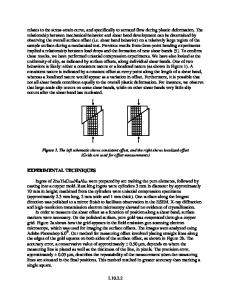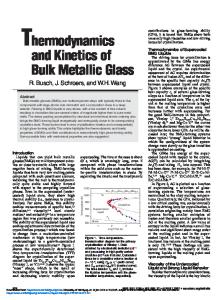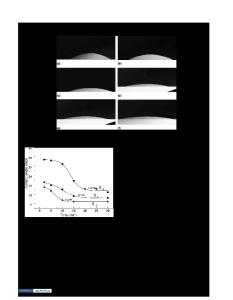Experimental Observations of the Failure Mechanisms in a Bulk Metallic Glass Composite
- PDF / 566,611 Bytes
- 6 Pages / 612 x 792 pts (letter) Page_size
- 69 Downloads / 342 Views
1048-Z05-01
EXPERIMENTAL OBSERVATIONS OF THE FAILURE MECHANISMS IN A BULK METALLIC GLASS COMPOSITE Hui Wang1, Ashraf Bastawros1, and S. Bulent Biner1,2 1 Aerospace Engineering, Iowa State University, 2271 Howe Hall, Rm 1200, Ames, IA, 500112271 2 Materials and Engineering Physics, Ames Laboratory (USDOE), Ames, IA, 50011 ABSTRACT The deformation and damage evolution behavior of a Ni-based bulk metallic glass composite reinforced with elongated brass phase is studied under cylindrical indentation. The estimated fracture toughness values based on the energy dissipation and the in-situ observation during the loading reveal the details of the damage evolution and toughening mechanisms in this composite system. The results indicate that the enhanced toughness of the BMG composite is plausibly an outcome of crack bridging mechanisms by the ductile brass phase, rather than a diffused array of nucleated shear bands in the hard BMG and arrest by the ductile reinforcing phase. INTRODUCTION Although metallic glasses exhibit unusual mechanical and physical properties such as extremely high strength and corrosion resistance, however, they also exhibit very limited ductility resulting from the highly localized shear bands, followed by crack initiation and unstable crack propagation [1-3]. On the other hand, it has been shown that the introduction of ductile metal reinforcements into the bulk metallic glasses (BMGs), in the form of composites, lead to higher ductility, fracture toughness and fatigue endurance [4, 5]. While it has been observed that the ductile phase would inhibit the propagation of localized shear bands within the BMG [6], it has been also seen that the shear bands can traverse ductile reinforcement [7]. In contrast, it has been also observed that the addition of more ductile particles increases the nucleation and formation of secondary bands [8]. The indentation experiments are increasingly being used to evaluate the mechanical properties of bulk metallic glasses, due to their very limited ductility [9-11]. The deformation field under the indenter experiences a constraint plastic flow, and thereby provides stable deformation path to study the evolution of the deformation mechanisms. In this study, the evolution of the deformation and damage in the BMG/Brass composite system was studied with an experimental set up that enables in-situ observations during the course of a wedge like cylindrical indentation. EXPERIMENT The studied composite was a Ni-rich Ni59Zr20Ti16Si2Sn3 metallic glass matrix, containing a 40% volume fraction brass phase and produced by warm extrusion technique (Fig. 1a). The details on this processing technique can be found in ref [12]. A homogeneous BMG matrix only sample “termed as monolithic BMG” was also prepared separately by identical warm extrusion processing for comparison (Fig 1b). The starting powder for the metallic glass matrix and brass reinforcements were initially spherical and resulting reinforcement morphology in the composite
Normal
was short discontinuous fibers and aligned
Data Loading...











